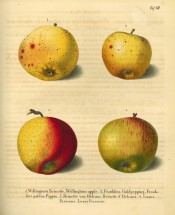Malus domestica ‘Dumelow’s Seedling’
Fruit; large, roundish, flattened. Skin; pale yellow, strewn with russet, pale red next the sun. Flesh; yellowish white, firm, crisp, brisk and very juicy, slightly aromatic flavour. [HP].
Horticultural & Botanical History
‘The tree is one of the strongest, and most vigorous growers, very hardy, and an excellent bearer. The young shoots which are long and stout, are thickly covered with large greyish white dots, which readily distinguish this variety from almost every other.
This excellent apple was raised by a person of the name of Dumeller, (pronounced Dumelow), a farmer at Shakerstone, a village in Leicestershire, six miles from Ashby-de-la-Zouch, and is extensively cultivated in that, and the adjoining counties under the names of Dumelow's Crab. It was first introduced to the neighbourhood of London, by Mr. Richard Williams, of the Turnham Green Nursery, who received it from Gopsal Hall, the seat of Earl Howe, and presented specimens of the fruit to the Horticultural Society in 1820. It was with him that the name of Wellington Apple originated, and by which only it is now known in the London markets. [Hogg p.73/1851].
Figured in Diel’s Deutschlands Kernobstsorten as ‘Wellington’s Reinette’ [Deutschlands Kernobstsorten t.7/1833], the illustration used here.
History at Camden Park
Listed as ‘Wellington’ in the 1850 and 1857 catalogues [Apple no.39/1850].
Notes
Published Apr 16, 2010 - 01:14 PM | Last updated Jul 25, 2011 - 03:33 PM

Apple ‘Wellington’ | Deutschlands Kernobstsorten t.7/1833 | Pomologische Bibliothek. Wellington is the yellow apple at top left.
| Family | Rosaceae |
|---|---|
| Category | |
| Region of origin | Garden origin, England |
| Synonyms |
|
| Common Name | Apple, Culinary apple, Keeping apple |
| Name in the Camden Park Record |
Wellington |
| Confidence level | high |